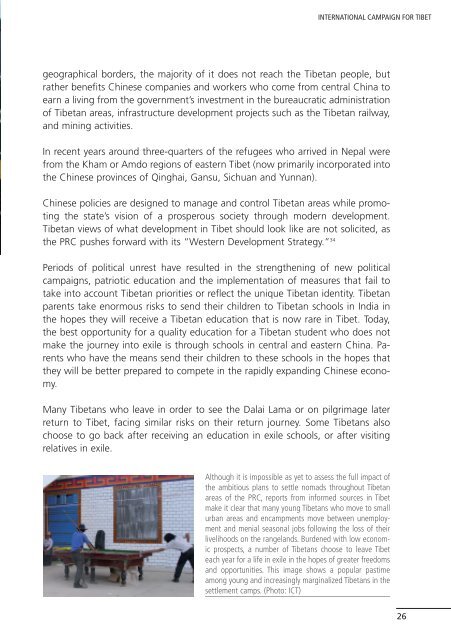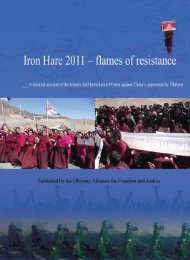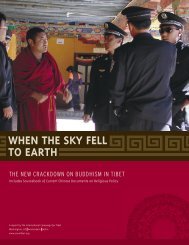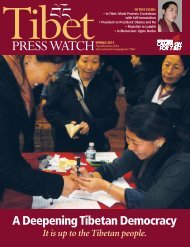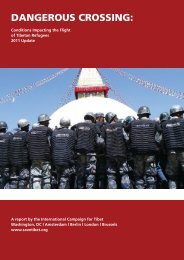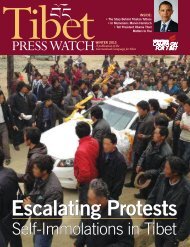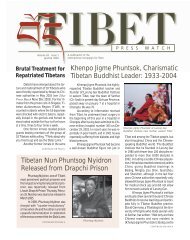DANGEROUS CROSSING: - International Campaign for Tibet
DANGEROUS CROSSING: - International Campaign for Tibet
DANGEROUS CROSSING: - International Campaign for Tibet
You also want an ePaper? Increase the reach of your titles
YUMPU automatically turns print PDFs into web optimized ePapers that Google loves.
INTERNATIONAL CAMPAIGN FOR TIBET<br />
geographical borders, the majority of it does not reach the <strong>Tibet</strong>an people, but<br />
rather benefits Chinese companies and workers who come from central China to<br />
earn a living from the government’s investment in the bureaucratic administration<br />
of <strong>Tibet</strong>an areas, infrastructure development projects such as the <strong>Tibet</strong>an railway,<br />
and mining activities.<br />
In recent years around three-quarters of the refugees who arrived in Nepal were<br />
from the Kham or Amdo regions of eastern <strong>Tibet</strong> (now primarily incorporated into<br />
the Chinese provinces of Qinghai, Gansu, Sichuan and Yunnan).<br />
Chinese policies are designed to manage and control <strong>Tibet</strong>an areas while promoting<br />
the state’s vision of a prosperous society through modern development.<br />
<strong>Tibet</strong>an views of what development in <strong>Tibet</strong> should look like are not solicited, as<br />
the PRC pushes <strong>for</strong>ward with its “Western Development Strategy.” 34<br />
Periods of political unrest have resulted in the strengthening of new political<br />
campaigns, patriotic education and the implementation of measures that fail to<br />
take into account <strong>Tibet</strong>an priorities or reflect the unique <strong>Tibet</strong>an identity. <strong>Tibet</strong>an<br />
parents take enormous risks to send their children to <strong>Tibet</strong>an schools in India in<br />
the hopes they will receive a <strong>Tibet</strong>an education that is now rare in <strong>Tibet</strong>. Today,<br />
the best opportunity <strong>for</strong> a quality education <strong>for</strong> a <strong>Tibet</strong>an student who does not<br />
make the journey into exile is through schools in central and eastern China. Parents<br />
who have the means send their children to these schools in the hopes that<br />
they will be better prepared to compete in the rapidly expanding Chinese economy.<br />
Many <strong>Tibet</strong>ans who leave in order to see the Dalai Lama or on pilgrimage later<br />
return to <strong>Tibet</strong>, facing similar risks on their return journey. Some <strong>Tibet</strong>ans also<br />
choose to go back after receiving an education in exile schools, or after visiting<br />
relatives in exile.<br />
Although it is impossible as yet to assess the full impact of<br />
the ambitious plans to settle nomads throughout <strong>Tibet</strong>an<br />
areas of the PRC, reports from in<strong>for</strong>med sources in <strong>Tibet</strong><br />
make it clear that many young <strong>Tibet</strong>ans who move to small<br />
urban areas and encampments move between unemployment<br />
and menial seasonal jobs following the loss of their<br />
livelihoods on the rangelands. Burdened with low economic<br />
prospects, a number of <strong>Tibet</strong>ans choose to leave <strong>Tibet</strong><br />
each year <strong>for</strong> a life in exile in the hopes of greater freedoms<br />
and opportunities. This image shows a popular pastime<br />
among young and increasingly marginalized <strong>Tibet</strong>ans in the<br />
settlement camps. (Photo: ICT)<br />
26


